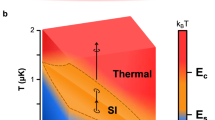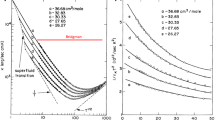Abstract
Understanding the dynamics of correlated many-body quantum systems is a challenge for modern physics. Owing to the simplicity of their Hamiltonians, 4He (bosons) and 3He (fermions) have served as model systems for strongly interacting quantum fluids, with substantial efforts devoted to their understanding. An important milestone was the direct observation of the collective phonon–roton mode in liquid 4He by neutron scattering, verifying Landau’s prediction1 and his fruitful concept of elementary excitations. In a Fermi system, collective density fluctuations (known as ‘zero-sound’ in 3He, and ‘plasmons’ in charged systems) and incoherent particle–hole excitations are observed. At small wavevectors and energies, both types of excitation are described by Landau’s theory of Fermi liquids2,3. At higher wavevectors, the collective mode enters the particle–hole band, where it is strongly damped. The dynamics of Fermi liquids at high wavevectors was thus believed to be essentially incoherent. Here we report inelastic neutron scattering measurements of a monolayer of liquid 3He, observing a roton-like excitation. We find that the collective density mode reappears as a well defined excitation at momentum transfers larger than twice the Fermi momentum. We thus observe unexpected collective behaviour of a Fermi many-body system in the regime beyond the scope of Landau’s theory. A satisfactory interpretation of the measured spectra is obtained using a dynamic many-body theory4.
This is a preview of subscription content, access via your institution
Access options
Subscribe to this journal
Receive 51 print issues and online access
$199.00 per year
only $3.90 per issue
Buy this article
- Purchase on Springer Link
- Instant access to full article PDF
Prices may be subject to local taxes which are calculated during checkout





Similar content being viewed by others
References
Landau, L. D. On the theory of superfluidity of helium II. USSR J. Phys. 11, 91–92 (1947)
Landau, L. D. The theory of a Fermi liquid. Sov. Phys. JETP 3, 920–925 (1957)
Pines, D. & Nozières, P. The Theory of Quantum Liquids (Benjamin, 1966)
Böhm, H. M., Holler, R., Krotscheck, E. & Panholzer, M. Dynamic many-body theory: Dynamics of Strongly Correlated Fermi Fluids. Phys. Rev. B 82, 224505 (2010)
Thouless, D. J. The Quantum Mechanics of Many-body Systems 2nd edn (Academic, 1972)
Pines, D. Elementary excitations in quantum liquids. Phys. Today 34, 106–131 (1981)
Feynman, R. P. & Cohen, M. Energy spectrum of the excitations in liquid helium. Phys. Rev. 102, 1189–1204 (1956)
Glyde, H. R. Excitations in Liquid and Solid Helium (Clarendon, 1994)
Nozières, P. Is the roton in superfluid 4He the ghost of a Bragg spot? J. Low Temp. Phys. 137, 45–67 (2004)
Jackson, H. W. Perturbative form of S(k,ω) for liquid 4He: basic calculation and results. Phys. Rev. A 8, 1529–1535 (1973)
Clements, B. E., Krotscheck, E. & Tymczak, C. J. Multiphonon excitations in boson quantum films. Phys. Rev. B 53, 12253–12275 (1996)
Campbell, C. E. & Krotscheck, E. Dynamic many-body theory: pair fluctuations in bulk 4He. Phys. Rev. B 80, 174501 (2009)
Friman, B. L. & Krotscheck, E. K. Zero sound, spin fluctuations, and effective mass in liquid 3He. Phys. Rev. Lett. 49, 1705–1708 (1982)
Krotscheck, E. &. Springer, J. Physical mechanisms for effective mass enhancement in 3He. J. Low Temp. Phys. 132, 281–295 (2003)
Boronat, J., Casulleras, J. & Grau, V. Krotscheck, E. & Springer, J. Effective mass of two-dimensional 3He. Phys. Rev. Lett. 91, 085302 (2003)
Glyde, H. R. et al. Effective mass, spin fluctuations and zero sound in liquid 3He. Phys. Rev. B 61, 1421–1432 (2000)
Sköld, K., Pelizzari, C. A., Kleb, R. & Ostrowski, G. E. Neutron scattering study of elementary excitations in liquid helium-3. Phys. Rev. Lett. 37, 842–845 (1976)
Scherm, R. et al. Pressure dependence of elementary excitations in normal liquid helium-3. Phys. Rev. Lett. 59, 217–220 (1987)
Greywall, D. S. Heat capacity of multilayers of 3He adsorbed on graphite at low millikelvin temperatures. Phys. Rev. B 41, 1842–1862 (1990)
Morhard, K.-D. et al. Two-dimensional Fermi liquid in the highly correlated regime: the second layer of 3He adsorbed on graphite. Phys. Rev. B 53, 2658–2661 (1996)
Bäuerle, C., Bunkov, Chen, A. S., Fisher, S. N. & Godfrin, H. Ultra-low temperature magnetic properties of liquid 3He films. J. Low Temp. Phys. 110, 333–338 (1998)
Casey, A., Patel, H., Nyéki, J., Cowan, B. P. & Saunders, J. Strongly correlated two dimensional fluid 3He. J. Low Temp. Phys. 113, 293–298 (1998)
Neumann, M., Nyéki, J., Cowan, B. P. & Saunders, J. Bilayer 3He: a simple two-dimensional heavy-fermion system with quantum criticality. Science 317, 1356–1359 (2007)
Godfrin, H. & Lauter, H. J. Progress in Low Temperature Physics Vol. XIV, Ch. 4, 213–320 (ed. Halperin, W. P. ) (Elsevier Science, 1995)
Lauter, H. J., Godfrin, H., Frank, V. L. P. & Leiderer, P. Ripplons in 4He films observed by neutron scattering. Phys. Rev. Lett. 68, 2484–2487 (1992)
Reatto, L. Novel substrates for helium adsorption: graphane and graphene-fluoride. Lecture given at Intl Conf. on Low Temp. Phys. (LT26) (Beijing, 15 August 2011)
Ruvalds, J. Are plasmons the key to superconducting oxides? Nature 328, 299 (1987)
Bostwick, A., Ohta, T., Seyller, T., Horn, K. & Rotenberg, E. Quasiparticle dynamics in graphene. Nature Phys. 3, 36–40 (2007)
Diaconescu, B. et al. Low-energy acoustic plasmons at metal surfaces. Nature 448, 57–59 (2007)
Uemura, Y. J. et al. Phase separation and suppression of critical dynamics at quantum phase transitions of MnSi and (Sr1-xCax)RuO3 . Nature Phys. 3, 29–35 (2007)
Kohsaka, Y. et al. How Cooper pairs vanish approaching the Mott insulator in Bi2Sr2CaCu2O8+δ . Nature 454, 1072–1078 (2008)
Acknowledgements
We are grateful to the Austrian–French programme Amadeus for providing initial support; to the Austrian Fonds zur Förderung der wissenschaftlichen Forschung (FWF grant P21264) , the French Agence Nationale de la Recherche (project ANR-2010-INTB-403-) and the EU FRP7 low-temperature infrastructure grant Microkelvin (project number 228464) for funding this research; and to the Institut Laue-Langevin for use of the facility.
Author information
Authors and Affiliations
Contributions
H.G., M.M., H.-J.L., A.S. and M.P. performed the neutron experiments; H.M.B., E.K. and M.P. developed the theory. All authors analysed the results and contributed to the work.
Corresponding author
Ethics declarations
Competing interests
The authors declare no competing financial interests.
Supplementary information
Supplementary Information
This file contains Supplementary Text and Data, which includes Supplementary Figure 1 and additional references. (PDF 543 kb)
Rights and permissions
About this article
Cite this article
Godfrin, H., Meschke, M., Lauter, HJ. et al. Observation of a roton collective mode in a two-dimensional Fermi liquid. Nature 483, 576–579 (2012). https://doi.org/10.1038/nature10919
Received:
Accepted:
Published:
Issue Date:
DOI: https://doi.org/10.1038/nature10919
This article is cited by
-
Path integral Monte Carlo approach to the structural properties and collective excitations of liquid \(^3{\text {He}}\) without fixed nodes
Scientific Reports (2022)
-
Electronic pair alignment and roton feature in the warm dense electron gas
Communications Physics (2022)
-
Roton-like acoustical dispersion relations in 3D metamaterials
Nature Communications (2021)
-
Exchange-Correlation Effects and the Quasiparticle Properties in a Two-Dimensional Dipolar Fermi Liquid
Journal of Superconductivity and Novel Magnetism (2020)
-
Anderson–Bogoliubov Collective Excitations in Superfluid Fermi Gases at Nonzero Temperatures
Journal of Low Temperature Physics (2019)
Comments
By submitting a comment you agree to abide by our Terms and Community Guidelines. If you find something abusive or that does not comply with our terms or guidelines please flag it as inappropriate.



